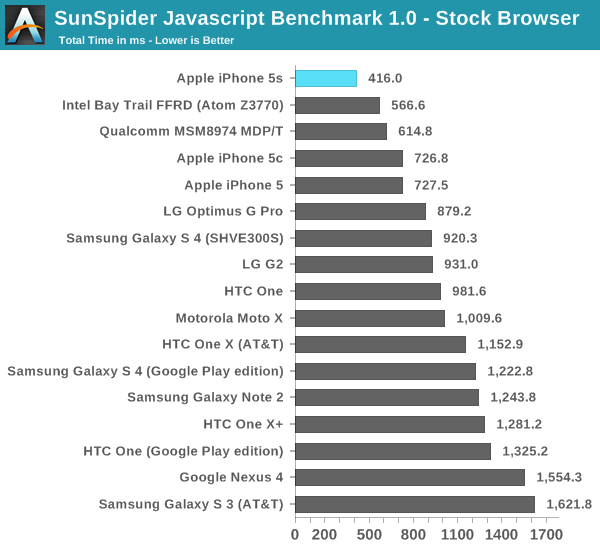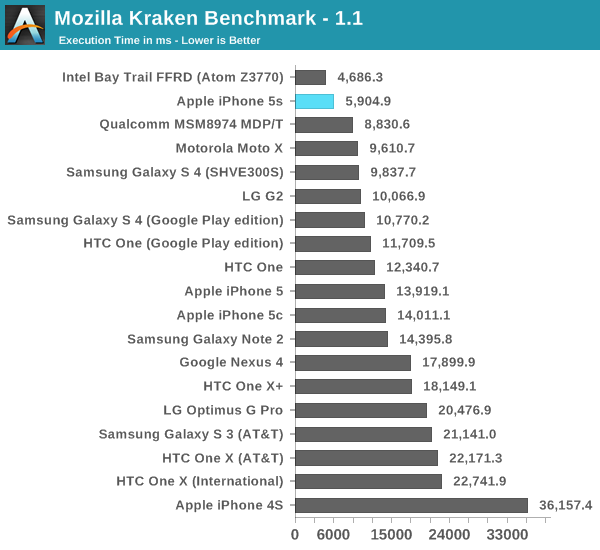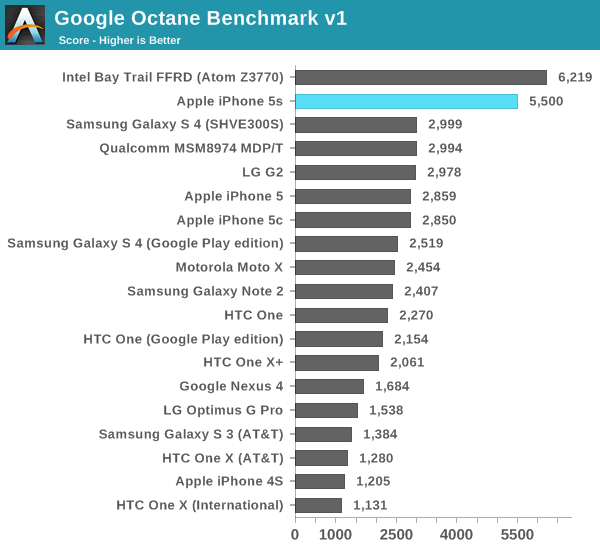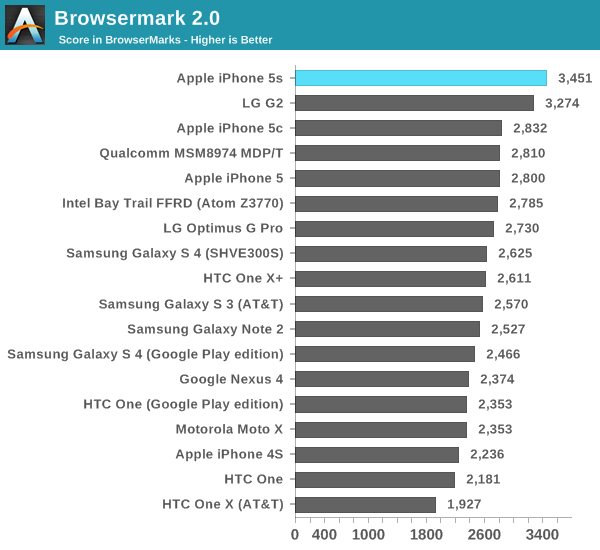The iPhone 5s Review
by Anand Lal Shimpi on September 17, 2013 9:01 PM EST- Posted in
- Smartphones
- Apple
- Mobile
- iPhone
- iPhone 5S
CPU Performance
For our cross-platform CPU performance tests we turn to the usual collection of Javascript and HTML5 based browser tests. Most of our comparison targets here are smartphones with two exceptions: Intel's Bay Trail FFRD and Qualcomm's MSM8974 Snapdragon 800 MDP/T. Both of those platforms are test tablets, leveraging higher TDP silicon in a tablet form factor. The gap between the TDP of Apple's A7 and those two SoCs isn't huge, but there is a gap. I only include those platforms as a reference point. As you're about to see, the work that Apple has put into the A7 makes the iPhone 5s performance competitive with both. In many cases the A7 delivers better performance than one or both of them. A truly competitive A7 here also gives an early indication of the baseline to expect from the next-generation iPad.
We start with SunSpider's latest iteration, measuring the performance of the browser's js engine as well as the underlying hardware. It's possible to get good performance gains by exploiting advantages in both hardware and software here. As of late SunSpider has turned into a bit of a serious optimization target for all browser and hardware vendors, but it can be a good measure of an improving memory subsystem assuming the software doesn't get in the way of the hardware.

Bay Trail's performance crown lasted all of a week, and even less than that if you count when we actually ran this benchmark. The dual-core A7 is now the fastest SoC we've tested under SunSpider, even outpacing Qualcomm's Snapdragon 800 and ARM's Cortex A15. Apple doesn't quite hit the 2x increase in CPU performance here, but it's very close at a 75% perf increase compared to the iPhone 5. Update: Intel responded with a Bay Trail run under IE11, which comes in at 329.6 ms.
Next up is Kraken, a heavier js benchmark designed to stress more forward looking algorithms. Once again we run the risk of the benchmark becoming an optimization target, but in the case of Kraken I haven't seen too much attention paid to it. I hope it continues to fly under the radar as I've liked it as a benchmark thus far.

The A7 falls second only to Intel's Atom Z3770. Although I haven't yet published these results, the 5s performs very similarly to an Atom Z3740 - a more modestly clocked Bay Trail SKU from Intel. Given the relatively low CPU frequency I'm not at all surprised that the A7 can't compete with the fastest Bay Trail but instead is better matched for a middle of the road SKU. Either way, A7's performance here is downright amazing. Once again there's a performance advantage over Snapdragon 800 and Cortex A15, both running at much higher peak frequencies (and likely higher power levels too, although that's speculation until we can tear down an S800 platform and a 5s to compare).
Compared to the iPhone 5, the 5s shows up at over 2.3x the speed of last year's flagship.
Next up is Google's Octane benchmark, yet another js test but this time really used as a design target for Google's own V8 js engine. Devices that can run Chrome tend to do the best here, potentially putting the 5s at a disadvantage.

Bay Trail takes the lead here once again, but again I expect the Z3740 to be a closer match for the A7 in the 5s at least (it remains to be seen how high the iPad 5 version of Cyclone will be clocked). The performance advantage over the iPhone 5 is a staggering 92%, and obviously there are big gains over all of the competing ARM based CPU architectures. Apple is benefitting slightly from Mobile Safari being a 64-bit binary, however I don't know if it's actually getting any benefit other than access to increased register space.
Our final browser test is arguably the most interesting. Rather than focusing on js code snippets, Browsermark 2.0 attempts to be a more holistic browser benchmark. The result is much less peaky performance and a better view at the sort of moderate gains you'd see in actual usage.

There's a fair amount of clustering around 2500 with very little differentiation between a lot of the devices. The unique standouts are the Snapdragon 800 based G2 from LG, and of course the iPhone 5s. Here we see the most modest example of the A7's performance superiority at roughly 25% better than the iPhone 5. Not to understate the performance of the iPhone 5s, but depending on workload you'll see a wide range of performance improvements.










464 Comments
View All Comments
helloworldv2 - Wednesday, September 18, 2013 - link
A good review would compare to the best in class, i.e. the Lumia 1020. Of course it would wipe the floor with the 5S, so that wouldn't be very good for Anandtech if they want to maintain good relations with Apple and all that..darkcrayon - Wednesday, September 18, 2013 - link
I think Apple is satisfied with their performance in the 5s form factor and understands it's a reasonable compromise vs sticking what looks like a section of an actual camera to the back of the phone, making an awkward 1/2 inch lump. And of course as an overall device the 5s it's much more advanced in other ways.Gridlock - Wednesday, September 18, 2013 - link
So Apple should have sent Anand a 1020?Or maybe Nokia PR should be slightly more awake.
120fps and 1024 available flash tones beats a Quasimodo Nokia for me.
Fleeb - Wednesday, September 18, 2013 - link
But in photography, in camera flash should only be used as a last resort.Petrodactyl - Monday, September 23, 2013 - link
if you're using remote flash with your phone camera, you're an idiot - and likely a bad photographer, to boot. Please try to stay within the realm of reality. Thanks.akdj - Wednesday, October 9, 2013 - link
It was an excellent review---and not just 'based' on photographic prowess. Is there a blog you've got going that provides 'good reviews'? I'm honestly interested because I found this one incredibly well written...and even responded, by the admin of the site---directly to you. He Didn't Have Your Beloved 1020. That said---plenty of comparison reviews if ALL you're interested in is the photographic abilities of the 5s. (There's a WHOLE lot more 'most' folks are seeking from their chosen phone). That said---Apple has always, for the time, provided top notch---maybe not always #1---but easily and consistently in the top 5 performers (including older models while a new one is released)...not to mention, the popularity to both developers and photo share sites speaks volumes to it's ubiquity. DPReview.com has an excellent and specific write up JUST for your helloworldv2 on the abilities (and downsides) to the iPhone 5s. Seems like an 8 or 10 page write up with plenty of comments for your to participate in as well. Seems like a better idea than coming in to a (possibly the most detailed on the net as well as insightful) site and bitching about one of the MANY functions of your 'pocket computer' review. Only so much time that can be set up to review each subject...and a finite amount of product---I'm sure in the lab hanging around, as well as the public choice...again ubiquitous---to choose Apple or Android en masse vs. Windows handsets at this point. If photography is your 'thing' (I shoot professionally, BTW)---grab a nice point and shoot. The Canon S110 or the new Sony RX100v2 are incredible performers....then you can own a decent phone too and not have to compromise!J
abrowne1993 - Wednesday, September 18, 2013 - link
Fair enough. I hope Brian gets the chance to do a comparison on here.bootareen - Tuesday, September 17, 2013 - link
There definitely is a display lottery. I've gone through around 7 iPhone 5's with different problems, but all had an interlace/scan line issue which is exactly what it sounds like. Even if you are further away from the screen and can't see the scan lines per se, the screen is noticeably less comfortable to look at and focus on with your eyes compared to a normal screen.Have you heard of this Anand, and are you aware of what would cause this issue?
fokka - Tuesday, September 17, 2013 - link
i can't really wrap my head around how the iphone can compete with high end android phones so well, even beating them by considerable margins in many benchmarks, although "only using a dual core" which is probably not even clocked as high as, say, a snapdragon 800?apple has put an emphasis on gpu-performance for a long time now, but seeing them on top so often and combining that with good battery life, all while using a miniscule battery (by android's standards) i have to say they are doing an astonishing job.
too bad i don't like apple software (and pricing).
Impulses - Tuesday, September 17, 2013 - link
The Moto X competes well with all the current quad cores too, it's not that big of a rarity... The fact that they can optimize for battery life better isn't that shocking either, it's the same deal as OS X... When you're only testing against a dozen models or so versus thousands you can do a lot more in this regard.